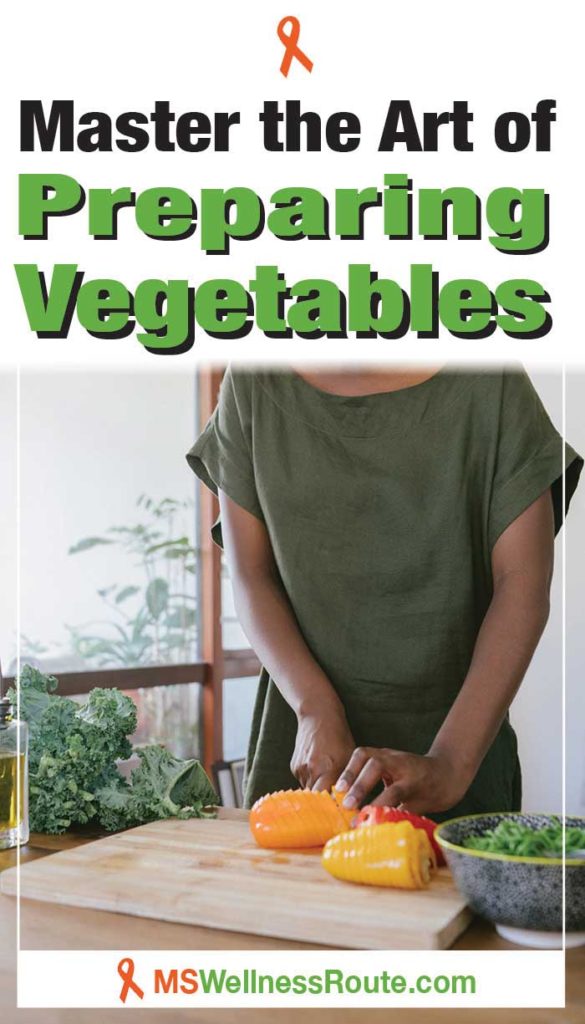Last Updated on November 18, 2023 by Cathy

When it comes to eating a nutrient-dense diet, vegetables should make up the majority of your diet. They’re loaded with antioxidants, minerals, phytonutrients, and vitamins. Vegetables are good for your health and your well-being.
You should aim to eat as many vegetables as possible. In the book, The Wahls Protocol, Dr. Terry Wahls recommends eating 9 cups of vegetables in one day. It sounds like a lot but once you get in the habit it becomes easier.
Dr. Wahls recommends eating 3 cups of each:
- Leafy greens
- Colorful all the way through such as beets and carrots
- Cruciferous such as asparagus, broccoli, bok choy, and cabbage
To get the benefits of vegetables, it’s nice to know how to prepare them. This makes preparing and eating vegetables more enjoyable. And you will stop throwing away the wilted vegetables you found in the back of your refrigerator.
The key to stopping wasting food and money is to learn how to prepare them and cook them. Don’t be afraid to try new vegetables like jicama or rutabaga, you may find a new favorite. And don’t make preparing vegetables a chore.
Different Categories of Vegetables
Botanically speaking they’re classified on which part of the plant they come from. Vegetables come from 9 different categories including the plant’s leaves, roots, and stems. But, to keep it simple we’ll stick with the three categories mentioned above.
Leafy Greens
Leafy greens are pretty easy to recognize. Unfortunately, some leafy greens are thrown away because people think they can’t eat them. Such as broccoli leaves, cauliflower leaves, and even the green tops of strawberries.
Leafy greens to eat:
- Arugula
- Beet greens
- Bok choy
- Carrot tops
- Chard
- Chicory
- Cilantro
- Collard greens
- Dandelion greens
- Endive
- Escarole
- Kale
- Lettuce (iceberg lettuce has little nutrients so eat different kinds)
- Mizuna
- Mustard green
- Parsley
- Radicchio
- Radish leaves
- Spinach
- Turnip greens
- Watercress
- Wheatgrass (it’s gluten-free)
Leafy greens are very versatile plus they’re packed with nutrients. Eat them raw or cooked, in soups and salads, in ground meats, and in smoothies.
Colorful All The Way Through

Vegetables get their color from phytonutrients. Phytonutrients help strengthen a plant’s immune system and protect us from chronic diseases. Colorful vegetables are rich it is in antioxidants, fiber, minerals, and vitamins.
Black/Blue/Purple vegetables:
- Black olives
- Cabbage, purple
- Eggplant (nightshade)
- Kale, purple
Green vegetables:
- Alfalfa sprouts
- Artichokes
- Brussel sprouts
- Cabbage, green
- Celery
- Green beans (legume)
- Herbs
- Leafy greens
- Okra
- Olives, green
- Peas (legume)
- Peppers, green (nightshade)
- Snow peas (legume)
Red/Yellow/Orange vegetables:
- Beets
- Carrots
- Pumpkin
- Red cabbage
- Red onions
- Peppers, red, orange, and yellow (nightshade)
- Rhubarb
- Sweet potatoes
- Tomatoes (nightshade)
- Winter squash
- Yams

Cruciferous Vegetables
Cruciferous vegetables aren’t as easily recognized. These are vegetables that belong to the Brassica family (cabbage family). You can identify them due to their four petals that resemble the cross-like shape of the flowers.
They are also known as sulfur vegetables or cole crops. Some people think the word “cole” is a variation of “cold.” They may even refer to them as cold crops because they grow in cooler weather. The word “cole” comes from a Latin word that means stem.
Cruciferous vegetables:
- Arugula
- Asparagus
- Bok choy
- Broccoli
- Brussel sprouts
- Cabbage
- Cauliflower
- Chives
- Collard greens
- Daikon
- Garlic
- Kale
- Kohlrabi
- Leeks
- Mizuna (Japanese mustard greens)
- Mushrooms
- Mustard greens
- Onions, all colors
- Radishes
- RutabagasScallions
- Shallots
- Tatsoi (Chinese cabbage)
- Turnip greens
- Turnips
- Watercress
Cleaning Vegetables

Now that you know what these vegetables are you can now prepare and cook them easily. Remember to eat 3 cups of vegetables from each group daily.
First – always clean your veggies!
Whether you got them from the grocery store, farmer’s market, or your garden you need to wash them. How to wash them depends on the journey they took from the Earth to your plate.
For example, wash root vegetables thoroughly since they grow in the dirt. Also thoroughly wash bok choy, celery, and leeks. As these vegetables grow, dirt gets caught inside their many layers of leaves.
Other vegetables that grow above the ground like herbs don’t need washing as thoroughly. If you grow your own vegetables you need to watch for bugs like aphids. Store-bought organic vegetables can also have what I like to call hitchhikers (bugs).
Water and a vegetable brush generally do the trick in washing vegetables. I use this vegetable brush. You can also use four parts water to one part vinegar to kill harmful microbes. Buy organic as much as possible, you can’t wash away pesticide residues.
Mushrooms are a little more tricky to clean because they get too soft very quickly. As you’re preparing to use them don’t let them soak for too long in water and pat them dry immediately. You can also buy a mushroom brush to safely clean them.
Cutting and Preparing Vegetables

When cutting vegetables make sure you are using a sharp knife. A dull knife can slip and cut your fingers. My favorite knife is a chef’s knife for chopping, cutting, or dicing. I also use a serrated knife for vegetables with softer skin.
Most vegetables don’t need a lot of explanation when it comes to cutting and preparing them. Other vegetables require very little preparation while others require a few extra steps.
Leafy greens depend on how you purchased them. If they are pre-washed you generally don’t need to do anything.
Leafy greens go bad quickly so only buy what you need. For leafy greens with a thick stem such as kale or Swiss chard, remove the stem then rip the leaves into ribbons. Save the stems for later use in stir-fries, soups, or smoothies.
Cruciferous vegetables like broccoli can get really messy when cutting them up. I found the easiest and cleanest way is to cut off the stem. This allows the florets to fall away into bite-sized pieces.
Some “vegetables” are actually a fruit such as cucumbers, yellow squash, and zucchini. They are fruit because they have seeds and develop from a flower just like an apple. But, because they don’t taste as sweet they are mostly considered a vegetable. Simply wash them off then cut them into your desired shape.
For stalk vegetables like celery simply chop off the root. Then you can chop, dice, or eat them as is, depending on your needs. They make great snacks with your favorite dip or with almond butter.
Some gourds and squashes can be a little harder to cut. To make it easier to cut, pierce the skin then microwave for 2-3 minutes. After it has cooled (if needed) cut the gourd/squash in half and scoop out the seeds.
Clean and save the seeds for later to roast and eat as a snack. Bake and after it’s cooled down cut it into the desired shape such as cubes, half moons, or rings.
Here is one of my favorite squash recipes: Cinnamon Delicata Squash
Methods To Cooking Vegetables
Sautéing has to be the easiest way to cook vegetables. Add chopped vegetables to a large skillet and add your favorite oil. Don’t use extra virgin olive oil because it has a low smoke point. Then add your favorite herbs like cinnamon, garlic, rosemary, or turmeric.
Steaming vegetables is another easy way of cooking vegetables. You can use a vegetable steamer or add your vegetables to a pan with water and cover it with a lid.
Quick Links To Information In This Post:
What Is The Wahls Protocol?
9 Easy Ways To Eat More Vegetables
How To Store Fruits And Vegetables
How To Save On Organic Groceries
Roasting vegetables is easy and delicious. In a large bowl add your favorite oil and herbs then add the vegetables and mix. I like to use a Pyrex bowl with a lid so I can flip it upside down to get it to mix well.
Then add the vegetables to a baking sheet lined with parchment paper. Roast the vegetables at 425º F for about 12-15 minutes. I “air fry” my vegetables using a Ninja Foodi, that way I can eat roasted vegetables without heating up my kitchen.
Master the Art of Preparing Vegetables
Over time chopping, dicing, and slicing vegetables will come easy and not feel like a chore. Remember, only buy what you need so they don’t go bad before you have a chance to use them. Try new vegetables and have fun!

Free Wellness Library!
Subscribe for free and I’ll send you the password to my secret library filled with many printables for your wellness journey.
Get Access to my FREE Library!

Subscribe for free and I'll send you the password to my secret library filled with MANY printables for your wellness journey.
You'll also be subscribed to my weekly newsletter with extra tips to get MS into remission and occasional recipes!
Enter my free resource library for my latest files and printables! Password is 'healthy' -- please copy and paste that in at the link above. Thanks for being a subscriber!!
Want to remember this health tip? Pin it to your favorite Pinterest board!

Image by Manfred Richter from Pixabay, Viktor at picjumbo, and Viktoria Slowikowska from Pexels
Master the Art of Preparing Vegetables
 MS Awareness Month Sale! All Ebooks 50% Off!
MS Awareness Month Sale! All Ebooks 50% Off! 




